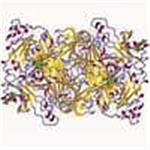Diamine Oxidase from porcine kidney has been used in the construction of histamine biosensor.
An enzyme occurring in the animal digestive system; it converts histidine to histamine.
Diamine oxidase attacks both diamines and histamine in much the same way that MAO attacks monoamines, forming aldehydes. This
enzyme is inhibited by carbonyl-blocking reagents and produces hydrogen peroxide, supporting the role of pyridoxal phosphate and the
flavin prosthetic groups in the catalytic action of the enzyme. Diamine oxidase is recovered in the supernatant after centrifugation and
removal of particulate matter. It is present in kidneys, intestines, liver, lung, and nervous tissue. It limits the biological effects of histamine
and the polymethylene amines putrescine and cadaverine. It also attacks monoamines, but at a higher substrate concentration.Plasma amine oxidases are in blood plasma of mammals and include spermine oxidase, which deaminates spermine and other polyamines.
Diamine oxidase from porcine kidney is a homodimer consisting of two equal subunits with a molecular weight of 87 kDa each. Each subunit contains one molecule of pyridoxal phosphate and one atom of copper. The molecular mass of the enzyme is found to be 170 kDa. The enzyme is a glycoprotein containing 5% hexose, 3.3% glucosamine, 2.6% N-acetylglucosamine, and 0.25% N-acetylneuraminic acid. The enzyme exhibits a high affinity for concanavalin A. Optimum pH with cadverine and histamine as substrates is found to be 6.3-7.4.
Diamine Oxidase catalyzes the oxidation of monoamines, diamines, and histamine to aldehydes, ammonia, and hydrogen peroxide. The enzyme is classified as a copper amine oxidase and it is a key enzyme in nitrogen metabolism. Diamine oxidase is inhibited by diethyldithiocarbamate, phenylhydrazine, semicarbazide, cyanide, isonicotinic acid hydrazide.
